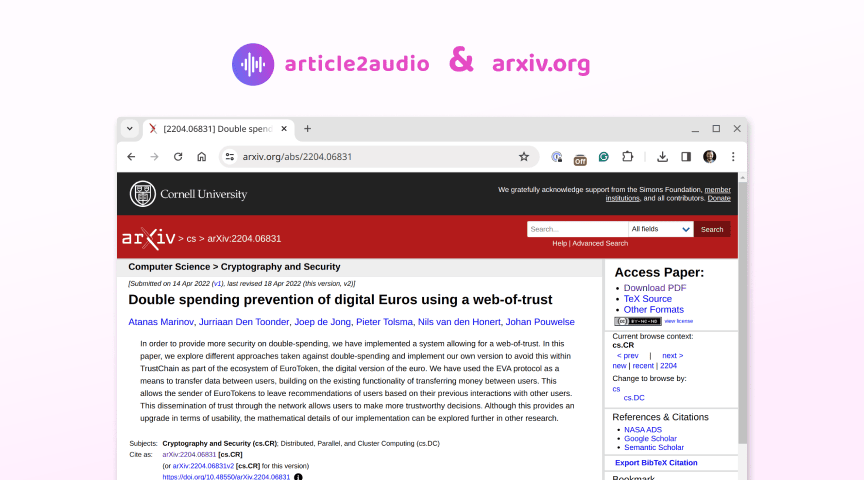UPDATE: The process is now much simpler. Just copy the HTML link (in the right sidebar of the arxiv page) and paste it into the article2audio app.
What is arXiv?
In the realm of science and research, arXiv sustains an important role. It is an esteemed archive where electronic research preprints, primarily from the fields of physics, mathematics, computer science, and quantitative biology, are kept. In essence, arXiv is a repository that scholars all over the globe depend on to share their work before it undergoes formal peer review. This pre-peer-reviewed information can then be accessed by researchers, students, and academics, becoming a crucial tool for the dissemination of scientific knowledge long before formal publication.

The Technology Behind Text-to-Speech
Pivotal to enhancing accessibility is the innovative technology of Text-to-Speech (TTS). TTS functions by converting written text into voice output. This powerful tool bestows the potential to make written content more accessible, notably for individuals grappling with visual impairments or learning disabilities. Through TTS, complexities and barriers often encountered with conventional reading methods are being revolutionized.
Challenges of Reading Papers from arXiv and TTS Solutions
Despite their significance and value, research papers are often dense, lengthy, and filled with technical jargon. These traits can create challenges for readers and potentially deter some from meaningfully engaging with the content. However, TTS technology offers a novel approach — taking these intricate academic texts and transforming them into audio. Not only does this enhance accessibility, but it also promotes efficiency and boosts students' engagement.
article2audio: A Premier Text to Speech App for Academics
Stepping into the limelight of TTS applications is article2audio. Focused on Web publications, this tool offers unique features that interpret and convert research papers from arXiv into audio. Key features are descriptive imagery and table summaries. Images are no longer silent; the AI describes them, providing a gist of the visual content. Similarly, researchers no longer have to painstakingly translate data from tables — the app synthesizes key insights.
Complex texts like programming code and pre-formatted texts are also given an audio makeover, making daunting materials easier to comprehend. Lastly, voice-overs are crafted to be meaningful and natural, enhancing the overall listening experience.
How to Use article2audio to Listen to Research Papers
To make use of the article2audio web app is a simple process. Primarily, a user must visit article2audio website and sign in using their Google or Apple account. Once logged in, you'll be prompted to paste a URL to a Web page. While article2audio doesn't support conversion of PDF files to audio, which is often shared on arXiv, there's a simple workaround:
- First, open an arXiv page in your browser. Like this:
https://arxiv.org/abs/1910.06709 - Then simply replace the letter "x" in the URL with the "5". A new URL will look like this:
https://ar5iv.org/abs/1910.06709 - Now, you can paste this URL into the article2audio app and convert it to audio.
Note: ar5iv.org is a website that allows viewing arXiv pages as HTML, which then can be used with article2audio.
It will take about 10 seconds for article2audio to fetch the contents of the page. Then, after clicking Convert the app will start generating the audio. It may take a while. Sometimes 10 minutes.
Conclusion: The Benefits of article2audio for All Readers
In an age where information is available in abundance, accessibility, and ease of understanding is key. With article2audio, this goal is one step closer. From dense research papers to intricate blog articles, article2audio provides an innovative means to engage with written content. By offering a user-friendly design and advanced TTS features, it breaks down barriers, making knowledge acquisition more efficient. So, why wait? Explore article2audio today and experience the future of reading!